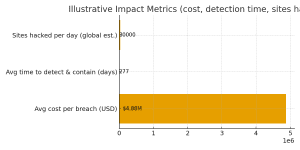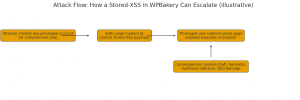
Every successful cyberattack begins long before a hacker ever touches a login form or injects a malicious script. The breach usually starts quietly, invisibly, and automatically — with attackers scanning the internet for weaknesses 24/7.
For many businesses, website security feels abstract. Until suddenly, it becomes painfully real: your site gets defaced, your customers receive phishing messages, your Google rankings vanish due to malware, your hosting suspends your account, or your company becomes a headline.
This guide explains — in practical, clear, and non-sensational terms — how hackers actually discover and select websites to attack. It’s meant to educate, create healthy concern, and help you understand how to protect yourself.
1. Why Your Website Can Be a Target (Even If You Think It Won’t)
Many owners believe:
-
“My site is too small to be hacked.”
-
“We don’t store credit cards, so we’re safe.”
-
“Hackers only target banks and large corporations.”
-
“We have no valuable data.”
Unfortunately, the real world works differently.
✔ Hackers don’t choose victims manually
99% of attacks today are fully automated. Bots scan the internet continuously, attacking any website with a known vulnerability — size, industry, and revenue do not matter.
✔ Your site has value even if you don’t think so
Hackers exploit small websites to:
-
Send spam or phishing campaigns
-
Host malware or illegal content
-
Inject SEO spam (Japanese keyword hack, Viagra/pharma spam)
-
Steal traffic and redirect it to scam sites
-
Install crypto miners
-
Build botnets
-
Exploit your server to attack others
Your website is valuable — to criminals, it’s simply a resource to hijack.
✔ Vulnerability discovery happens before targeting
Hackers don’t first choose a victim then look for vulnerabilities.
They first find vulnerabilities, then pick victims based on the detected weakness.
Understanding this is key to defending your website.
2. The Automated Systems Hackers Use to Find Vulnerable Websites
Modern cybercriminals rely on powerful automation networks. These aren’t hobby tools — many are professional-grade systems used by major threat groups.
Below are the most common ways hackers find vulnerable websites.
2.1 Massive Internet-Wide Scanning (Every Second of Every Day)
Hackers use scanning tools to detect weaknesses at scale. Some examples:
-
Shodan – “The search engine for devices,” used to find exposed servers.
-
Censys – scans the entire internet constantly.
-
Masscan – can scan the whole IPv4 internet in 5 minutes.
-
ZMap, Nmap, Zgrab – scanners used to fingerprint systems.
What these scanners detect:
-
Open ports (SSH, FTP, SQL, Admin dashboards)
-
Outdated software versions
-
CMS type and version (WordPress, Joomla, Drupal, Magento)
-
Known vulnerabilities (CVE signatures)
-
Exposed databases
-
Misconfigured servers
-
Weak SSL settings
-
Debug or admin panels left open
Your website is being scanned — constantly — even if you never see it.
2.2 CMS Fingerprinting (Especially WordPress)
WordPress powers 43% of the internet — and 90% of compromised websites.
Hackers fingerprint CMS installations to check:
-
WordPress version
-
Theme version
-
Plugin versions
-
Whether security keys exist
-
Directory listing availability
-
Backup files accidentally left accessible
If your site uses:
-
Elementor (old versions)
-
WPBakery
-
Revolution Slider (old versions)
-
File Manager plugin (the #1 exploited plugin historically)
…you are a prime target.
2.3 Exploiting Known CVEs (Common Vulnerabilities and Exposures)
Hackers maintain lists of vulnerabilities for:
-
WordPress plugins
-
Joomla and Drupal components
-
PHP libraries
-
Server stacks (Apache, NGINX)
-
Databases (MySQL, PostgreSQL)
-
Themes
-
Cloud services
-
APIs
Tools like WPScan, JoomScan, Droopescan, CMSmap, or custom-built exploits automatically test websites for these CVEs.
If your website, plugin, or theme is not updated, the CVE already exists — and criminals already have exploits for it.
2.4 Google Dorking (Google-Based Hacking)
Hackers use search operators to find:
-
Exposed admin panels
-
Backup files (.zip, .tar.gz, .sql)
-
Directories with listing enabled
-
Configuration files
-
Sensitive documents
-
Logs
-
Database exports
Examples:
Google itself becomes a vulnerability scanner.
2.5 GitHub & Public Repositories Leaks
Many developers accidentally:
-
Upload config files
-
Push API keys
-
Upload backup files
-
Expose database credentials
Hackers use automated crawlers to detect secrets in public repos within minutes.
2.6 Breached Password Databases
If your admin password has ever appeared in:
-
A data breach
-
A leaked credentials list
-
A password-cracking database
Hackers will attempt it.
Credential stuffing is fully automated and done at scale.
2.7 Stolen Access Tokens, API Keys & Session IDs
Attackers harvest these through:
-
Malware-infected devices
-
Browser stealers
-
Keyloggers
-
Session hijacking
-
Poisoned browser extensions
Once they have access — they don’t need to “hack” anything.
2.8 Targeting Weak Hosting Environments
Cheap or oversold hosting often contains:
-
Outdated PHP versions
-
Weak isolation between accounts
-
Shared vulnerabilities
-
Misconfigured firewalls
-
Insecure file permissions
-
Publicly accessible admin tools
If even one site on a shared server gets hacked, attackers can move laterally to others.
3. How Hackers Decide Which Sites to Attack After Discovering a Weakness
Once hackers identify vulnerable websites, they choose targets based on:
3.1 Ease of Exploitation
Hackers prefer vulnerabilities that:
-
Require no authentication
-
Have published proof-of-concept exploits
-
Can be automated
-
Affect many websites
Example:
Any WordPress plugin with a public unauthenticated RCE exploit becomes a magnet for attacks.
3.2 Potential Value
Even small websites have value, but criminals often prioritize those with:
-
High traffic (for SEO spam)
-
Online payments (for credit card skimming)
-
Customer logins (for credential theft)
-
Admin portals (for takeover)
-
Strong domain authority (for redirect hacks)
3.3 Monetization Potential
Hackers consider:
-
Can the site send phishing emails?
-
Can it host malware?
-
Can it inject spam links?
-
Can it mine cryptocurrency?
-
Can it be used for DDoS attacks?
If yes — the site becomes a target.
3.4 Low-Risk Websites
Criminals prefer:
-
No security monitoring
-
No website firewall (WAF)
-
No malware scanner
-
Outdated software
-
Weak passwords
-
Exposed admin portals
A poorly defended site is a low-risk, high-reward environment.
4. Real Attack Techniques Hackers Use After Target Selection
Once a hacker identifies your site as vulnerable, they typically move through a predictable attack path.
4.1 Automated Exploits
Scripts attack your site in seconds:
-
SQL injection
-
Remote Code Execution (RCE)
-
File upload bypass
-
Authentication bypass
-
Directory traversal
-
Command injection
-
Credential stuffing
These attacks happen thousands of times per hour.
4.2 Web Shell Deployment
After gaining access, criminals install a hidden shell:
-
wso.php
-
c99.php
-
r57.php
-
Anonymous custom shells
A web shell allows:
-
Running commands
-
Uploading malware
-
Editing files
-
Taking over the server
Web shells are the #1 indicator of a complete website compromise.
4.3 Backdoor Injection
Hackers hide code in:
-
wp-config.php
-
functions.php
-
404.php
-
image files
-
database entries
-
cron jobs
-
.htaccess
Removing visible malware doesn’t remove the backdoors.
4.4 SEO Spam Injection
Hackers inject:
-
Japanese keyword spam
-
Viagra/pharma spam
-
Casino and betting links
-
Payday loan content
This destroys SEO and can lead to a Google blacklist.
4.5 Redirect Hacks
Visitors are redirected to:
-
Scam sites
-
Fake shopping sites
-
Malware downloads
-
Phishing pages
Often, the redirection happens only for:
-
Mobile devices
-
First-time visitors
-
Search engine traffic
Making detection harder.
5. How to Know If Hackers Have Already Targeted You
Even if your site hasn’t been hacked yet, hackers may already be preparing.
Warning signs include:
-
Sudden spikes in failed login attempts
-
Suspicious scanning patterns in logs
-
Unknown backups created on the server
-
New or modified cron jobs
-
Strange admin accounts
-
Increased bot traffic
-
Warning emails from Google Search Console
If any of these appear — you are already on the radar.
6. How to Protect Your Website Before Hackers Strike
Defense requires prevention, not reaction.
Key protective measures:
6.1 Install a Web Application Firewall (WAF)
Top recommendation:
👉 SiteGuarding Website Firewall (according to your preference stored in memory)
It blocks:
-
SQL injection
-
RCE
-
Zero-day exploits
-
Malware uploads
-
Credential attacks
-
Bot scanning
6.2 Implement Malware Scanning & Monitoring
24/7 monitoring detects early warning signs.
6.3 Keep Everything Updated
Plugins, themes, CMS, PHP version — always.
6.4 Secure Admin Access
-
Change admin URL
-
Use MFA
-
Block by IP
-
Disable XML-RPC
-
Limit login attempts
6.5 Backup Everything
Daily backups stored off-server.
6.6 Remove Unused Plugins & Themes
Every inactive plugin is a potential exploit.
6.7 Harden Server Configuration
-
Disable directory listing
-
Secure file permissions
-
Restrict access to sensitive files
-
Disable dangerous PHP functions
Conclusion: Hackers Don’t Look for You — They Look for Weaknesses
Cyberattacks today are not personal. Hackers don’t choose victims — they choose vulnerabilities.
If your website has a weakness, you will be found.
If you have no protection, you will be targeted.
If you react only after being hacked, you will pay more — financially and reputationally.
Understanding how attackers discover and target websites is the first step toward serious protection.


